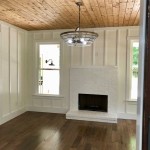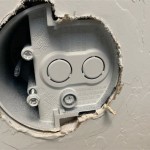What Kind of Paint to Use on Ceiling Medallions
Ceiling medallions serve as decorative elements enhancing the aesthetic appeal of a room, typically accentuating light fixtures or ceiling fans. These medallions, often crafted from materials like plaster, polyurethane, or wood, require proper painting to maintain their appearance and integrate seamlessly with the overall décor. Selecting the appropriate type of paint is crucial for achieving a durable, visually pleasing finish that complements the medallion's design and the surrounding ceiling.
The choice of paint depends on several factors, including the medallion's material, the desired aesthetic, and the environmental conditions of the room. Each paint type offers distinct advantages and disadvantages with regard to adhesion, durability, finish, and application. A thorough understanding of these factors is essential for making an informed decision and ensuring a successful painting project.
Understanding Medallion Materials and Their Paint Requirements
The material composition of a ceiling medallion exerts a significant influence on the type of paint that will adhere effectively and provide a lasting finish. Different materials possess varying porosities and surface characteristics, requiring specific paint formulations to ensure proper bonding and prevent issues such as peeling or cracking.
Plaster Medallions: Plaster medallions, commonly found in older homes, are porous and require priming before painting. An oil-based primer is often recommended for raw plaster to seal the surface and prevent moisture absorption. Once primed, plaster medallions can be painted with either latex or oil-based paints. Latex paints offer the advantage of easier cleanup and lower VOC (Volatile Organic Compounds) emissions, while oil-based paints provide a harder, more durable finish, particularly suitable for high-humidity environments.
Polyurethane Medallions: Polyurethane medallions are a synthetic alternative to plaster, offering greater resistance to moisture and cracking. These medallions typically come pre-primed from the manufacturer, simplifying the painting process. Latex paints are generally the preferred choice for polyurethane medallions due to their flexibility and compatibility with the material. Acrylic latex paints, known for their excellent adhesion and durability, are particularly well-suited for this application. Before painting, it's essential to clean the medallion thoroughly with a mild detergent to remove any dust or residue.
Wood Medallions: Wood medallions, though less common, can add a unique rustic or traditional element to a room. These medallions require priming with a wood primer to seal the grain and prevent the paint from being absorbed unevenly. Both latex and oil-based paints can be used on wood medallions, depending on the desired finish and level of durability. For interior applications, latex paints are generally sufficient, while oil-based paints may be preferred for exterior wood medallions exposed to the elements.
In all cases, a test area should be painted initially to ensure proper adhesion and color accuracy before proceeding with the entire medallion. This step is crucial for identifying any potential compatibility issues and preventing costly mistakes.
Choosing the Right Paint Finish for Ceiling Medallions
The paint finish, referring to the degree of sheen or reflectivity, significantly impacts the overall appearance of a ceiling medallion. Different finishes offer varying levels of durability, cleanability, and aesthetic appeal, influencing the perceived texture and detail of the medallion.
Flat Finish: Flat finishes possess the lowest sheen, effectively concealing imperfections and creating a smooth, uniform appearance. This finish is ideal for ceilings with surface irregularities or for achieving a subtle, understated look. However, flat finishes are less durable and more difficult to clean compared to other finishes, making them less suitable for high-traffic areas or areas prone to staining.
Matte Finish: Matte finishes offer a slightly higher sheen than flat finishes, providing a greater degree of durability and cleanability while still maintaining a soft, non-reflective appearance. This finish is a versatile option suitable for various rooms and décor styles, offering a balance between aesthetic appeal and practical functionality.
Eggshell Finish: Eggshell finishes possess a low-luster sheen, resembling the surface of an eggshell. This finish is more durable and easier to clean than flat or matte finishes, making it a popular choice for living rooms, bedrooms, and hallways. Eggshell finishes offer a subtle sheen that enhances the color and detail of the medallion without being overly reflective.
Satin Finish: Satin finishes provide a moderate sheen, offering good durability and cleanability. This finish is often used in bathrooms and kitchens due to its resistance to moisture and stains. While satin finishes enhance the color and detail of the medallion, they can also highlight imperfections in the surface, requiring careful preparation and application.
Semi-Gloss Finish: Semi-gloss finishes possess a high sheen, offering excellent durability and cleanability. This finish is commonly used on trim, doors, and moldings, providing a glossy, reflective surface that is easy to wipe clean. While semi-gloss finishes can create a dramatic effect on a ceiling medallion, they are best reserved for medallions with intricate details that warrant highlighting. They can also accentuate any imperfections in the medallion's surface or the ceiling itself.
Gloss Finish: Gloss finishes have the highest sheen, offering exceptional durability and cleanability. This finish is typically used for high-use areas, such as kitchens and bathrooms, and is generally not recommended for ceiling medallions due to its highly reflective surface that can be visually distracting.
The choice of finish depends on the desired aesthetic and the functional requirements of the room. For most ceiling medallions, a matte, eggshell, or satin finish provides the optimal balance of appearance, durability, and cleanability.
Application Techniques and Considerations
Proper application techniques are essential for achieving a professional-looking paint finish on a ceiling medallion. This involves thorough preparation, careful application of primer and paint, and attention to detail throughout the painting process.
Surface Preparation: Before painting, the ceiling medallion must be thoroughly cleaned to remove any dust, dirt, grease, or other contaminants. A mild detergent and water solution can be used to clean the surface, followed by a thorough rinsing with clean water. Any loose paint or debris should be scraped away with a putty knife or scraper. Holes or cracks should be filled with spackle or joint compound and sanded smooth before priming.
Priming: Priming is a crucial step in painting ceiling medallions, particularly those made of plaster or wood. Primer seals the surface, promotes adhesion, and prevents the paint from being absorbed unevenly. An oil-based primer is recommended for raw plaster or wood, while a latex primer is suitable for polyurethane medallions or previously painted surfaces. The primer should be applied in a thin, even coat using a brush or roller, ensuring complete coverage of the medallion's surface. Allow the primer to dry completely according to the manufacturer's instructions before proceeding with the paint.
Painting: The paint should be applied in thin, even coats using a high-quality brush or roller. For intricate details or hard-to-reach areas, a small brush with fine bristles may be necessary. Avoid applying too much paint at once, as this can lead to drips and runs. Allow each coat of paint to dry completely before applying the next coat. Two coats of paint are typically sufficient for achieving full coverage and a uniform finish. When using a roller, consider using a nap that’s suitable for the surface texture of the medallion and ceiling.
Special Considerations: When painting a ceiling medallion that is already installed, protect the surrounding ceiling and light fixture with drop cloths and painter's tape. Work carefully to avoid getting paint on these surfaces. If necessary, use a small brush to touch up any areas where paint has strayed. Pay close attention to the edges of the medallion, ensuring a clean, crisp line where it meets the ceiling. For medallions with intricate details, consider using a technique called "dry brushing," where a small amount of paint is applied to a dry brush and then lightly brushed over the surface to highlight the details.
Safety Precautions: Always wear appropriate safety gear when painting, including gloves, a mask, and eye protection. Work in a well-ventilated area to avoid inhaling paint fumes. Follow the manufacturer's instructions for the proper disposal of paint and cleaning supplies.
By following these application techniques and considering the specific characteristics of the ceiling medallion, a durable, visually appealing finish can be achieved, enhancing the overall aesthetic of the room.

How To Paint A Ceiling Medallion

How To Paint A Ceiling Medallion Destashio

How To Paint A Ceiling Medallion The Easy Way Atta Girl Says

How To Paint A Ceiling Medallion The Easy Way Atta Girl Says

How To Paint A Ceiling Medallion

How To Paint A Ceiling Medallion The Easy Way Atta Girl Says

How To Paint A Ceiling Medallion

How To Paint A Ceiling Medallion The Easy Way Atta Girl Says

Ceiling Medallion Wall Art Sand And Sisal

How To Paint A Ceiling Medallion The Easy Way Atta Girl Says
Related Posts








